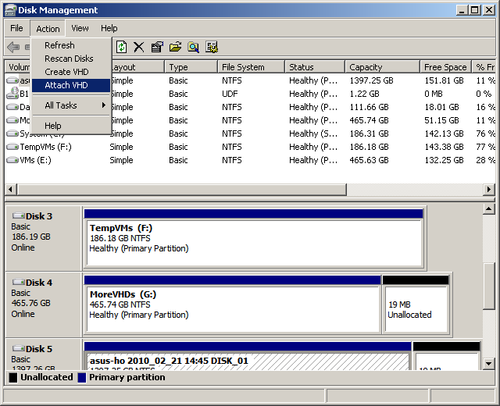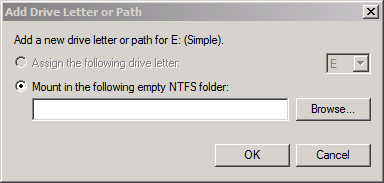5. Breaking a Mirror
If a disk fails and you can’t replace it with an identical
one, break the mirror until a replacement becomes available.
Breaking a mirror severs the connection between the two disks,
allowing the remaining disk to continue to function normally until a
replacement disk becomes available. When the replacement disk is
available, the mirror can be re-created.
You might also find it useful to break a mirror even when both
disks are still functioning, because you then end up with two
identical copies of the same data. One half of the broken mirror
continues to have the same drive letter or mount point, while the
second half of the broken mirror is assigned the next available
drive letter. To break a mirror, complete the following
steps:
In the Disk Management console, right-click either disk of
the mirrored volume.
Choose Break Mirrored Volume from the shortcut menu. You’re asked to confirm
that you really want to break it.
Click Yes, and the mirror is broken. You’ll have two
volumes. One retains the drive letter or mount point of the
original mirror, and the other is assigned the next available
drive letter. They will both contain exact duplicates of the
data at the instant of the break but will immediately start to
diverge as they are modified.
6. RAID-5 Volumes
Windows Small Business Server 2011 supports a software
implementation of RAID-5 that allows you to have a redundant file
system without the 50-percent capacity overhead of using mirrored
volumes. The overhead on a RAID-5 volume decreases for each additional disk you
add to the volume, making this the most space-efficient method of
providing redundancy in SBS.
Unfortunately, this efficiency doesn’t come without some
costs. RAID-5 arrays are inherently slower at write operations than
even a plain old stand-alone drive. You also don’t have the
flexibility that you have with mirrored volumes in SBS. You can’t
simply remove a drive from a RAID-5 volume, nor can you break a
failed drive out of the volume, allowing the remaining drives to
regenerate. Further, when a disk fails on a RAID-5 volume, not only
is the volume no longer redundant, but it also gets a lot slower
because both read and write operations must calculate the correct
value for every byte read or written.
Some of the tasks you do with a mirror also apply to a
RAID-5 volume. You can
Create the RAID-5 volume.
Assign a mount point or drive letter to the RAID-5
volume.
Format the RAID-5 volume.
Continue to use the RAID-5 volume after the failure of one
of the disks in the volume.
What you can’t do with the software RAID in SBS is add or
remove disks from the RAID-5 volume after you have created it,
except for replacing a failed disk. To be able to dynamically add
and remove disks from a RAID-5 array, the solution is to choose a hardware RAID array that
supports dynamic reconfiguration.
|
The name you assign to a volume, partition, or drive should
tell you something about it rather than simply mimicking the drive
letter. A volume name like “Big140SAS” tells you pretty
conclusively that it’s that big new SAS drive you just
bought—unless, of course, you already have a half-dozen of them on
your server, in which case you’re going to need to come up with a
more effective name. On the other hand, a volume name of “C_DRIVE”
is just about useless, because the drive letter is available from
anywhere that the volume name is. A common scheme is to assign
volume names based on the primary use of the volume, so “UserHome”
or “DB_STORE” makes it pretty clear which volume it is from a
logical (but not necessarily physical) view. we’ve moved to
preferring this logical view of volume names—in an era of widely
available hardware RAID solutions, combined with virtualized
servers and virtual hard drives, the particular physical
characteristics of a drive are less important than the logical
ones. On our server, it’s all part of a large SAS array underneath
anyway.
|
7. Mounting a Virtual Hard Disk
If you’re running SBS 2011 on a physical server, as opposed to
a virtual machine, you can still take advantage of the flexibility
and disaster recovery features of virtual hard disks. With SBS, you
can both create and directly mount (attach) a
virtual hard disk (VHD) file and then treat it just like any other
hard disk. To attach a VHD, complete the following steps:
Open the Disk Management console if it isn’t already
open.
Select Attach VHD from the Action menu, as shown in Figure 20.

Specify the location and name of the VHD file, and click
OK to attach the VHD. If this is a new VHD, you’ll need to
initialize it just as you would a new physical hard disk.
8. Mounting a Volume
SBS borrows a concept from the UNIX world by adding the
ability to mount a volume or partition on a subfolder of an existing
drive letter. A mounted volume can also have a drive letter
associated with it, although it does not need to, and it can be
mounted at more than one point, giving multiple entry points into
the same storage.
A volume must be mounted on an empty subfolder of an existing
NTFS volume or drive. FAT and FAT32 drives do not support mounted volumes. You can mount only a single volume at
a given mount point, but you can then mount further volumes on top
of an existing mounted volume, with the same rules and restrictions
as any other mount. An important caution, however: the properties of
a drive do not show all the available disk space for that drive,
because they do not reflect any volumes mounted on the drive.
Further, mounted volumes are not supported with Windows Services for
UNIX on shared Network File System (NFS) exports.
Mounted volumes can be used to provide a mix of redundant and
nonredundant storage in a logical structure that meets the business
needs of the business while hiding the complexities of the physical
structure from the users, but this approach does pose potential
issues during disaster recovery and for some kinds of file
access.
The volume being mounted appears to users as a simple
directory. This feature makes it possible to create larger file
systems that use multiple hard disks without the inherent risks of
using spanned volumes, because the failure of any one of the mounted
volumes affects only the directories that were part of that volume.
To mount a volume, complete the following steps:
From the Disk Management console, right-click a volume or
partition. Choose Change Drive Letter And Paths from the
shortcut menu. The Change Drive Letter And Paths dialog box
opens.
Click Add to open the Add Drive Letter Or Path dialog box
shown in Figure 21.

You can type the mount point or click Browse to select or
create a mount point. Any empty directory that resides on a
nonremovable NTFS volume can be the mount point.
After you select or type the mount point, click OK, and
the volume or partition is mounted.
Warning:
IMPORTANT It’s actually
easy to get yourself into trouble with this new feature. Disk
Management lets you make multiple levels of mounted volumes,
including ones that are recursive. You’re well advised to mount
volumes only at the root level of a drive. Trying to mount below
that point can lead to confusion and make management and
documentation difficult. Also, verify with your backup vendor that
mount points are fully supported by their application.